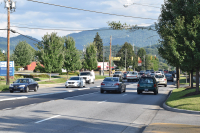Bringing in the feds: EPA agreement mandates elements of Canton mill cleanup
Pactiv Evergreen, owner of the shuttered papermill in Canton, has been working to clean up two separate seeps leaking toxic substances into the Pigeon River under an administrative order of consent (AOC) with the Environmental Protection Agency.
March kicks off 2024 ozone season
March 1 marked the beginning of the 2024 ozone season as state and local environmental agencies renew their daily air quality forecasts for ozone across North Carolina.
Coming down the pipe: EPA mandate could soak local utility customers
A recent update to the U.S. Environmental Protection Agency’s Lead and Copper Rule directs nearly all of the nation’s water systems to conduct an inventory of service lines by October, checking for the presence of lead pipes due to their well-established health risks.
The rollback administration
The present administration is no friend to the environment.
In a New York Times analysis, which was based on data from Harvard Law School, Columbia Law School and other sources, the Times reported more than 90 environmental rules and/or regulations had been or were in the process of being rolled back. According to the report, 58 rollbacks had already occurred and 37 were in process.
The Naturalist's Corner: Speak up
If you want the opportunity to have knowledge about and input on actions, policies and/or decisions affecting property you own, you need to speak up now. The present administration and the USDA Forest Service announced, in June, plans to “streamline” the National Environmental Policy Act (NEPA) protocols when it comes to actions receiving federal funding on federal lands, which the public owns.
Vehicle emissions testing goes up in smoke
A multi-year effort by Burnsville Republican Rep. Michele Presnell to scrap vehicle emissions testing requirements in more than two dozen North Carolina counties finally got the green light from the U.S. Environmental Protection Agency.
EPA — the Eviscerated Protection Agency
Our new denier-in-chief believes “The concept of global warming was created by and for the Chinese in order to make U.S. manufacturing non-competitive.”
EPA looks to end 30 years of contamination at old Benfield site
 It’s been 32 years since Benfield Industries in Hazelwood burned to the ground, 25 since the Environmental Protection Agency designated it as a Superfund site and 13 since cleanup on the site finished.
It’s been 32 years since Benfield Industries in Hazelwood burned to the ground, 25 since the Environmental Protection Agency designated it as a Superfund site and 13 since cleanup on the site finished.
But the work’s not done, according to the most recent EPA monitoring. The agency is hoping that its latest remediation plan for the former chemical distribution company site will take care of creosote contamination in Hazelwood once and for all.
Is it worth it?
Despite years of negative publicity surrounding the contamination of soil at Barber’s Orchard, the actual health risk posed by the soil is miniscule, according to the Environmental Protection Agency. The only health hazard comes from eating the soil, not just once or twice accidentally, but on a regular basis for 30 years.
“It’s 30 years of eating two grams of dirt per day,” said Jon Bornholm with the Environmental Protection Agency. “Kids were the main concerns because they are the ones more likely to eat some dirt.”
Consuming Barber’s Orchard dirt at that rate would increase the risk of getting cancer by one in 10,000, or by .01 percent.
According to the American Cancer Society, more than 30 percent of adults will get cancer. Eating dirt daily from Barber’s Orchard for 30 years would bump a person up from a 30 percent to a 30.01 percent chance of getting cancer.
There is no risk from touching the dirt, inhaling the dirt, eating vegetables grown in the dirt or eating livestock that grazed on the site — but only from direct and repeated digestion.
Monkeys to the rescue
Pollution in the soil varies from higher concentrations to none at all. Figuring out how much was too much was not easy. Could soil with only the slightest trace amounts be left where it is, or did it all have to go?
To answer that question researchers bagged up soil from Barber’s Orchard and sent it off to a lab where it was fed to monkeys. The monkeys were then studied to determine how much arsenic from the soil was actually absorbed into their blood stream. Pigs were also fed doses of the Barber’s Orchard soil.
The study equaled good news for taxpayers’ wallets. It turned out the absorption of arsenic from eating the soil was less than originally thought. The threshold for acceptable arsenic level was lowered from 40 parts per million to 80 parts per million.
That in turn downwardly revised how much soil had to be removed, from 117 acres to only 88 acres. And the price tag on the project fell from an estimated $24 million to $15 million.
Uphill battle to purge Barber’s Orchard of dirty soil
Residents of Barber’s Orchard will safely be able to eat the dirt on their lots after a $15 million federal cleanup of the subdivision.
Trace levels of arsenic in the soil date to its former days as an apple orchard, when underground pipes leached arsenic-laced pesticide, landing it on the Environmental Protection Agency’s Superfund list.
Given the cleanup cost, it might have been cheaper to condemn the contaminated land and pay the owners for it, but that’s not what EPA does.
“That was my first thought too. The law does not allow us to do that in this case. If there is a risk the law requires us to clean it up as best as we can,” said Jon Bornholm, an EPA Superfund project manager out of Atlanta.
State taxpayers are on the hook for 10 percent of the clean-up cost. The state signed a contract pledging its commitment back in 2005.
While it is a dramatically different economic — and political — landscape today, the state can’t go back on the commitment, according to Nile Testerman, a state environmental engineer who serves as a liaison to the EPA on Superfund projects.
“They have already allocated the money for this clean up,” said Testerman.
When contaminates were discovered in 1999, the EPA tested the soil and water on all the lots where people were living. Of the 90 homes in the subdivision at the time, about 25 required immediate soil removal.
“We only cleaned up the manicured portion of contaminated yards. If somebody owned five acres, but only half an acre of that was a yard with a lawn, that half acre is the only part that was cleaned up,” said Bornholm.
The cost during the first phase was $5 million, plus another $2.3 million to run a water line to service homeowners who could not safely drink from their wells.
Ensuing soil tests of the entire subdivision showed that 45 percent of the remaining acreage is contaminated. The costly cleanup requires digging up and hauling off the top foot of soil from 88 acres.
The work is supposed to be done in September, but contractors have been working six months already and only removed 25,000 cubic yards — there’s another 90,000 to go. Bornholm seemed skeptical they would finish by September but said the contractors claim it will get faster as they go.
The work is being performed under a no-bid contract by ERS, Emergency Rapid Response. Instead of awarding the job to the lowest bidder, EPA is being billed hourly for the labor and equipment used on the job by ERS, a pre-approved contractor for Superfund sites.
“In a project like this there are too many unknowns,” Bornholm said. “The agency felt this was the cheapest approach versus going out for bid.”
The contractor, based in St. Louis, has about 40 workers on site. Bringing in clean soil accounts for about $3 million of the total project cost. That portion of the job was bid out, going to Caroline-A-Contracting run by Burton Edwards of Maggie Valley.
Where to put all that dirt?
Trucking away and disposing of the old dirt will account for about a third of the project’s cost.
The soil must be dumped in a lined landfill, but it’s a lot of dirt, and would make a pretty big dent in most landfills. In Haywood County, where taxpayers recently ponied up $4.5 million for a landfill expansion, there wasn’t the space to spare. Buncombe County’s landfill turned it away as well.
“Haywood County does not have the space and Buncombe simply does not want it,” Bornholm said.
The EPA initially found a willing taker at a landfill in South Carolina. That option was dropped in favor of a landfill in Athens, Tenn. Trucking costs, plus landfill fees for every ton, would still be exorbitant, however.
A cheaper — and closer to home — option may be on the horizon. Evergreen paper mill in Canton owns a private landfill for its industrial waste, and has recently filled up one of its cells. It needs dirt, lots of it, to cap it off, and Barbers Orchard certainly has some to spare. It could well be a match made in heaven.
The mill and EPA are still in negotiations over a soil deal. The mill must also get permission from the state Department of Environment and Natural Resources to use the soil for landfill cover.
With contractors stuck in holding pattern over the dirt’s ultimate resting point, they’ve had to construct a second lined holding area to stock pile it.









